#ok some lichens
Explore tagged Tumblr posts
Note
Hello! I found this on a fallen tree. I wasn't sure if it was lichen or a mushroom - it seems to grow in the way mushrooms do bit looks more like lichen with the colour and texture. Do you happen to know which it is?
Thank you!



This is an old, dried out Stereum (i think) fungus that has algae growing on it. There is also lichen growing on the trunk of the tree, but the 2 are unrelated. You can totally see how lichens came to be when you see how messy this tiny ecosystems are and how often algae and fungus grow together.
46 notes
·
View notes
Text
If you’re coming over here from my main blog @whitegoldtower (I am deeply sorry) you probably don’t need to read all this. For those of you, however, who have chosen death…
Hi.
I’m Afallach, this is me and my silly little (s)elf insert, Zilvantar.


🕷️As House Patron, I have a few rules.🕷️
Under 18’s, please do not interact with me. I’m an adult and I’m not comfortable discussing adult things with kids. It’s weird.
Don’t be poisoning the air over here with any sort of -phobia. Particularly transphobia. I am a proud, intersex transgender man and I do not take kindly to being trifled with.
If you have arachnophobia, look away now. This is a drow-themed special interest blog: there will be spiders. And I do not wish to give anybody nightmares… unless their name is Marcus.
Fuck you, Marcus.
Everything I write about on here is purely either for fun or educational. I will be writing about some nasty things like poisons and what they do to a human body. This is not your incentive to attempt a DIY. Likewise, if you find a mushroom in the wild, DO NOT eat it unless you’re 1000% certain you know what it is.
If you’re not comfortable with topics such as BDSM and Monsterfucking, this is likely not the blog for you: the majority of the time, my brain is drowning his sorrows in Menzoberranzan’s filthiest gutters.
🕸️Made it this far? Great!🕸️
🕷️This my house. Entry, please. 🕷️
I have a lot of special interests. This blog is for this portion of them:
#mushrooms lichen and fungi
#Drow Lore
#Poisons
#Spiders (and some other arachnids)
#Crystals
#BG3 Stuff that fits the vibe
#Alchemy and Medieval Medicine
🕷️🕸️🕷️
If you’ve read all the way to the bottom of this post, thanks. Here, take this. It’s dangerous to go alone. 💜

My Drow Tavs/Durges:
Malhounnet Do’Urden: Circle of Spores Druid/Bard, Noble, MTF Transfem
Tam’lin Baenre: Szarkai Gloomstalker Ranger, Noble/Folk Hero, Minthara’s Cousin, Descendant of Gromph Baenre
Vesz: Bhaalspawn Barbarian/Monk (War-Priest of Lolth), Haunted One, Resist Durge, Intersex FTM
Zilvantar Arkentyl: Wizard/Sorcerer (Arachnomancer), Noble/Sage, favourite of Alak’niss Rilynath (my DnD OC, Archmage of Sorcere, who is also an Arachnomancer and dethroned/usurped Pharaun Mizzrym)
Yazdaer Mizzrym: Rogue/Hexblade Warlock (Zhentarim), Noble/Charlatan, Descendant of Greyanna Mizzrym and Pharaun Mizzrym.
Nathurra Agelenidae: Blood Sorcerer, Embrace (?) Durge - still working on her. Haunted One, my almost murder hobo (her name is literally based on the Hobo Spider). Minthara’s lover. Is going to scalp Orin’s braid off her head when she gets her hands on her. Sister rivalry but make it 🎀worse🎀
My D&D OC:
Alak’niss Rilynath: FTM noble, Sorcerer/Wizard Arachnomancer and Arch-Mage of Sorcere. Had a dalliance with Gromph Baenre, and assassinated the arch-mage who succeeded him (Pharaun Mizzrym) to assume the title of Archmage at Sorcere, having an advantage in doing so for his female anatomy. Fearfully referred to as the ‘Spider King’, as rumours say he is a ‘Consort of Lolth’, having been ‘kissed by the Spider Queen,’ as the only House Patron to be given the advantage of being blessed with a female form at birth, part of his body also naturally armoured with a spider-like carapace, which spread with his use of magic. He is also feared for his jet black hair, which, in Drow Society, is said to be a bad omen - and a bad omen he was, indeed, for the Rilynath House, as when they sought to eliminate him for the ‘treachery’ of his transition, he picked them off one by one until only he was left.
“My bloodline ends with me.”
Lawful Evil/True Neutral.
Read Alak’niss’ Fic Here!
#intro post#tav#bg3#drow oc#dnd drow#drow tav#dnd#special interest blog#lgbt dnd#ok now for the tags to organise this mess#mushrooms lichens and fungi#drow lore#poisons#spiders (and some other arachnids)#crystals#bg3 stuff that fits the vibe#alchemy and medieval medicine
4 notes
·
View notes
Note
Hi, out of curiosity...can we actually propagate lichens in our backyards? Is it feasible? It seems like a good idea to help or allow them thrive in residential areas
ok ive gotten asks like this before and the answer is that like... unless you're a lichen researcher person and youre gathering existing lichens of the species you want outside and culturing them on plates in a lab for an experiment (how lichens are grown in a lab if i remember correctly because growing one from scratch with a fungal spore and a compatible algal spore still doesnt work, you still need the sourdough starter, and even then it takes a long time and is really hard), for the most part the lichens, they command respect in a way that plants dont, you see. the lichen chooses to grow where it wants, when it wants. it chooses the substrate and conditions and sticks to it. those microhabitats are hard to replicate and they take so long to grow and are so variable in their preferences, my advice is that if you want to have more lichens in your life, look into what organic substrates you want to attract wants, and leave those substrates lying around or growing in your backyard untouched for 10+ years. or alternatively find a patch and visit them. or alternatively move to a coastline if you havent already because they love the mist that rolls in and the temperate temperatures.
may i suggest visiting an old graveyard that doesnt scrape them off regularly? because they are loving graveyards let me tell you. perhaps an old retaining wall or big tree that for some reason has a lot of them on there while the other trees don't have as much. lichens are the kings of seeing one hyperspecific substance and going I Sleep and then seeing the same substance 4 feet to the left and going oh nevermind the 17-year-4-month-old-cinderblock-remnants-with-a-ittle-bit-of-dirty-water-dribbling-on-them-enjoyers have logged tf on actually
883 notes
·
View notes
Text
From the Nest 3
(i might change the name of this au, to make it more obvious that it's a Jaune trained by Raven au)
_ main hall _
Jaune: *hands in pockets, looking bored* I was expecting a rousing speech. Instead, we just got told that "practice is more useful than theory". As if we never fought grimms before.
Yang: *shrug* Most of the students never fought grimms before.
Jaune: *snort* Good one! Next you'll tell me nobody learned how to make camps and live in the woods.
Yang: ...
Jaune: *Nervous* Y-Yang, you did learn how to survive during your travels, right?
Yang: ... *Looking to the side* I went camping with my father... Once or twice...
Jaune: *pointing to Weiss* I was expecting that from Ms moneybags-
Weiss: Hey!
Jaune: *turning to Weiss* Do you know how to prepare a deer so it won't spoil in a matter of a day?
Weiss: Well, no, but-
Jaune: Do you know which mushrooms you can eat? What type of lichen to use as an antiseptic?
Weiss: Nobody learned that yet!
Jaune: *serious* Then what happens if you lose your food? If you are lost in the middle of Mistral? *Sigh* I'm beginning to think my teacher was right about city folks.
Yang: *placing a hand on Jaune's shoulder* Hey, relax! I'm pretty sure we are supposed to learn those things anyway.
Ruby: *reading the pamphlet* Yep, we got botany and survivalism studies. At least, if we pass initiation.
_ later _
Ruby: *looking around, putting her sleeping bag on the ground* Where's Jaune?
Yang: I think he said he was sleeping outside. Something about not liking crowded spaces.
*three students, hearing that, packed their stuff and went outside*
Ruby: *wince* He's not gonna like the school life, huh?
Yang: *chuckle* Probably will take him some time to get used to, yeah.
Weiss: *mumbling, preparing her sleeping spot* Can't believe how rude he was. Acting as if i was an idiot!
Yang: *rolling her eyes* Are you planning on complaining all night?
_ outside _
Jaune: *sitting next to a tree, taking firewood from his travel bag* Should be good for the night. *Look at the little group approaching him* Hm?
Nora: *waving with a big smile* Heya! Do you mind if we keep you company?
Jaune: *smiling* Not at all! I just don't like closed space with a lot of people when sleeping.
Ren: *putting his sleeping bag on the ground* Agoraphobia?
Jaune: *shaking his head* No, just don't like the noise.
Blake: *sitting next to the tree, her back against it* Don't mind me, i'll just read.
Jaune: *chuckle* Fine by me.
Nora: *glancing at Jaune's bag* Oh? You're making food?
Jaune: *shrug with a smirk* haven't eaten yet. *Placing the wood and some dried up lichen then use a flint and iron to start the fire*
Ren: Seems like you're used to it.
Jaune: *chuckle* Well, i had to survive in the woods for a while. Everyone does that where i'm from.
Nora: *Beaming* Us too! *Realising something important* I'm Nora Valkyrie, by the way! Nice to meet you!
Ren: *sitting down* I'm Lie Ren.
Jaune: *nod* My name's Jaune.
Nora: *tilting her head* No family name?
Jaune: *Scratching the back of his head* It's complicated.
Nora: ok! *turning her head to Blake*
Blake: *trying to ignore her* ...
Nora: *smiling*
Blake: *sigh* Blake Belladonna. Happy now?
Nora: Yes~!
#jaune arc#blake belladonna#lie ren#nora valkyrie#ruby rose#yang xiao long#weiss schnee#rwby#rwby au#from the nest au
151 notes
·
View notes
Text


Northern & Southern European Dyes Palette(s)
It's been almost exactly two years since I made my Iron Age Palette. To celebrate that anniversary... No, you know what, actually not, it's a total coincidence ��� I was working on a new thing and started wondering about this and that; to not bore you with the details, let's just say that one thing let to another and of course I ended up revisiting the very basics. So here it is! Not one, but TWO new colour palettes for our oldtime-y sims. Based on the lives of my Britons at some point in 1st century CE, shortly before the Roman conquest.
An important note: the southern palette is actually rather an add-on than a separate palette. As in, Romans would surely have access to the dyes from the northern palette as well. But as stated above, I made this whole thing from the viewpoint of a British Celt, hence we have two palettes: one with dyes which he could just obtain from native plants and the other with those he'd have to import. The southerners were more blessed in this aspect :]
You can download PDF files for both of those palettes and .txt files to be used in Paint.net (put them in Documents\paint.net User Files\Palettes). EDIT: the amazing @kyrassimhoard went ahead and made the .aco version of the palettes for all the Photoshop users! Thank you so much Kyra (also, special thanks to @aheathen-conceivably for double checking them for me 💗)
DOWNLOAD them on my Patreon! (always free, no early access etc.)
Apart from a bunch of visual changes (maybe the font will actually be readable this time? Gasp!), there's some new stuff in the palettes themselves (duh). Let's take a quick look, shall we?
undyed wool - hard to call it a dye, lol, but ofc it had to be here. The so-called primitive sheep of the Brittonic era looked quite different from what we imagine when we think 'sheep', and they most certainly came not only in white, but also in many shades of brown or even black. Perfect for making a colourful garment even without any dyes;
birch leaves - easy to obtain, easy to dye; almost no changes here, other than one added shade which used to be under 'mixed ingredients' before;
birch bark - OK, I don't remember where I took the old colours from, but I'm afraid I was being too optimistic. Birch bark gives rather pinkish than reddish shades; actually, it needs a looooooong soak and proper pH to turn anything but very bright, subtle pink. But it seems you can get them and they don't wash out that easily, so - there you go;
elderberry - here I was for sure being too optimistic, especially with that one pretty, saturated blue shade which got thrown away. From what I've read (and seen in photos...), elderberry is a very tricky dye, not particularly water- and lightfast. 'Not particularly' is mildly put - it just washes out in no time, leaving you either with a very pale or very greyish shade of the once vibrant colour. Adjusted accordingly (and they're still too pretty tbh);
apple leaves/twigs - that's a bit of a tricky point, because the Internet claims it was only Romans who brought apples to Britain. But at the same time apple cider was Britain's national drink allegedly already during the Celtic times. Heck, Welsh mythical island of Avalon literally means 'isle of apples', and mythology tends to be... you know... old. Huh? After a bit of research on the topic I'm inclined to believe that what Romans really brought with them were big, sweet apples and their organised cultivation; but small, tart, 'untasty' varieties did exist in Britain even before, growing in the wild. Perfect for making cider - or dyes 😉;
nettle - no changes here. Easy, cheap, grows everywhere, just that the colours are probably not something you'd wear to a party;
hedge bedstraw - seems it's growing everywhere in Britain, so it's plausible the ancients would've made use of it;
lichen - aaaaalriiight, now, that is a big discovery! Beautiful shades and absolutely possible to obtain from the varieties growing on the British Isles. One of the most crucial omissions from my old palette, here finally in its full glory.
That was it for the northern palette. And the southern? Glad you asked:
weld - previously called 'dyer's rocket', but no one in the whole wide natural dyeing Internet calls it that. Beautiful, vibrant, very steady yellow; won't give away even if you overdye it with indigo or woad. It's native to the Mediterranean and while it was cultivated in Britain in later centuries, I have no reason to believe that was also the case in 1 c. CE. I dub it imported;
madder - I keep reading that it's giving saturated red shades, but I have yet to see anyone dye a skein of yarn deep red with madder only. All that keeps popping up in pictures are gentle, pinkish reds, so that's what I included in my palette too. The orange comes from changed pH of the water;
woad - OK, that's my most epic fail of all. To make a Celtic palette and not include woad?! Putting aside the whole matter of Britons possibly maybe but actually maybe not using it to paint their faces (a very controversial matter, let's not go there 😅), woad was the blue dye in those times. Indigo was far away and while it was being imported to Rome, afaik it was used mostly for painting, not cloth dyeing; and besides, as crazy as it may sound, woad seems to do the job better. Seriously. Higher water and light fastness. The question is, was it cultivated in Britain or imported? Just like weld, it's native to the Mediterraean. There is a British find of a bunch of woad seeds, from 1 c. BCE - but then again, it's just one find. So... Mostly imported but slowly being introduced to the Isles? Maybe?
mixed ingredients - the ingredients specified in the PDFs are given in the order they're used - that makes a difference! My biggest discovery of this whole natural dyeing research is that, surprisingly, vibrant green is the absolutely most difficult colour to obtain. That dark green you see at the bottom - so-called Lincoln green - requires super high levels of both weld and woad, and you must put your yellow skein in the blue dye asap - if you're too slow, you get a lighter shade, e.g. like the one above it. The Hightowers surely knew how to show they're rich, huh...?
and last but not least, the luxury dyes! Some imported from far away (turmeric), some from nearby lands (Tyrian purple), some even grown locally (there were saffron plantations on Sicily. True story), but nevertheless, all super duper expensive. Tyrian purple was actually legally reserved for the emperor only - even if you could, by some miracle, afford it, you'd probably get arrested if you dared to dress in that particular shade of purple. Good that lichens could always come to the rescue!
Guess that's enough of behind-the-scenes trivia, isn't it? Props to you if you managed to get to this point, lol. Have fun with the palettes and happy recolouring!
***
Sources:
dzikiebarwy.com - in Polish, but the pictures should speak for themselves. Here you've got a post about dyeing with summer plants, including birch leaves, here - elderberry, here - apple leaves and twigs, here - nettle;
https://woolandpalette.com/blogs/news/making-vibrant-green-with-natural-dyes was my first step in finding out how to obtain a proper green shade with natural dyes;
wooltribulations.blogspot.com - dyeing with birch bark (here), another failed elderberry experiment (here) and overdyeing weld with woad for a deep Lincoln green shade (here);
www.jennydean.co.uk - an absolute godsend, especially two posts: 'Dyes of the Celts' (here) and 'Colours of the Romans' (here);
https://craftinvaders.co.uk/making-dye-from-lichen/
https://earlychurchhistory.org/fashion/colors-dyes-for-clothing-in-ancient-rome/ - on the posh dyes for the rich;
https://www.butserancientfarm.co.uk/gallery - except for the general vibe (*chef's kiss*), the 'animals and nature' section of the gallery has pictures of the 'primitive' sheep which they keep at the farm;
...and a bunch of others which I didn't save in my bookmarks 🙃
54 notes
·
View notes
Note
not a desert technically but I just visited the dunes in Monterey and gleefully trampled on some ice plant and I feel like you might enjoy that. if you wanna talk about the kinds of vegetation that grow in sandy soil or something I invite you to 👀
(also you're doing it! you're surviving! you'll get through that doctorate!)
ok ready this is my most important soapbox of all because soils in the desert are very special and have such cool organisms you don't find in these arrangements outside of drylands...
first lookee here. wauw beautiful utah

ok now look closer

no closer closer closer
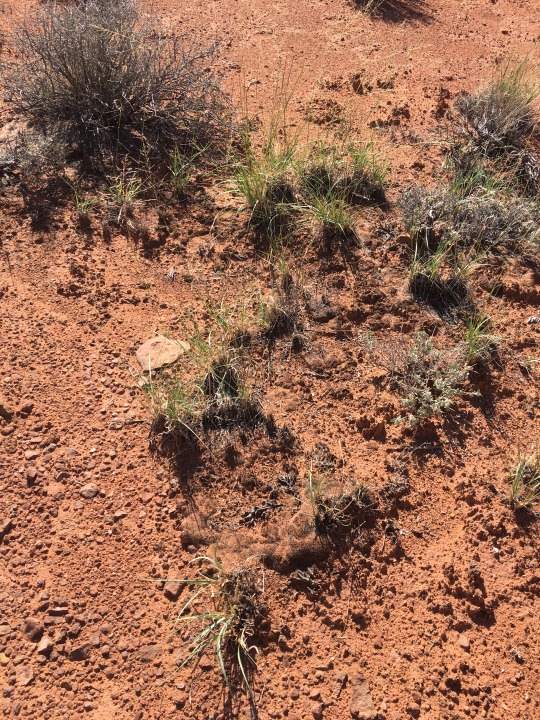
CLOSER CLOSER CLOSER

WOW is that MOSS? you are thinking. the answer is YES. but doesn't moss like lots of water you are thinking??? WELL USUALLY. BUT in the desert you will notice that things like grasses and shrubs have lots of space between them unlike in more temperate climates-vegetation cover is not truly continuous. And there's less leaf litter than in forests obscuring the dirt. Which means all that soil is just sitting out in the open with nothing to protect it from being blown away by those harsh desert winds... except of course for our friends the BIOLOGICAL SOIL CRUSTS. also known as crypotbiotic soils, cryptogrammic soils, and biocrusts (for short).
These are communities of mosses, lichens, cyanobacteria (aka blue green algae--yes, those are usually Wet too, but ironically so so common in deserts), and the tens of thousands of surface and subsurface microbes that are associated with them. It's easy to forget just how many organisms are living in one single scoop of soil, especially because science can barely identify 1% of these microbes. Like of JUST the ones we have enough info to classify enough to count in my own master's dataset left me with over 25,000 unique taxonomic units I had to manage. don't worry about what that means just know it was very annoying and makes statistics a headache. anyway you find them all over the southwest US states as well as in other deserts around the world (spain, australia, sooo many in china, incredible ones in the succulent karoo in south africa/namibia, plenty in argentina etc etc), if you know where to look...

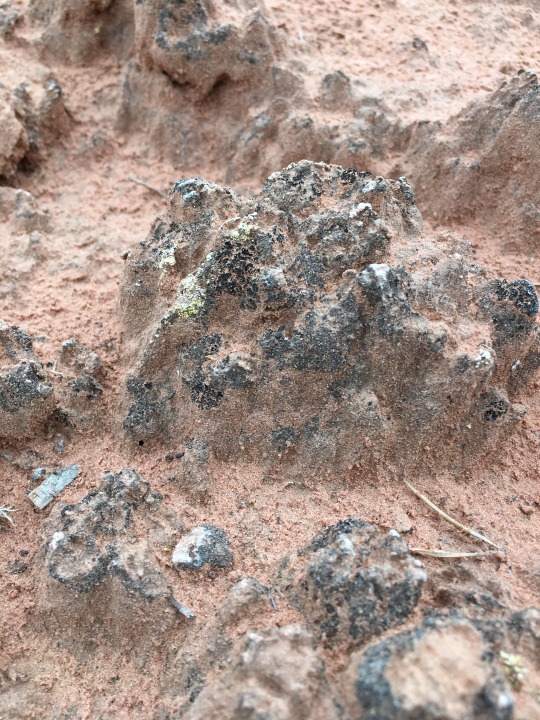




anyway OUR HEROS THE BIOCRUST aren't just there to look pretty (though you will can see from photos they also do this :) ), but are a vital component to the dryland ecosystem! They literally hold the soil surface together to prevent erosion, they influence hydrology in terms of rainfall runoff + infiltration, they impact how seeds germinate, they contribute to nutrient cycling and what plant-available compounds are held at the soil surface... like i feel like Tumblr in general has been made aware of how fungi & root networks interact in large scale systems like forests, but that is also happening on a more microscopic level in deserts! just in the top couple centimeters soooo much is happening. Cyanobacteria in particular are tiny organisms that produce little nets of sugars woven in the soil to climb around on and protect themselves, and if you crumble a little bit of soil from the surface you can see how the little spiderweb strings literally hold together the sand particles.
Now that you're Aware of biocrusts, when you look at larger scale landscape photos taken in un-trampled areas of desert, you will notice them as darker patches and textures on the lighter soil:



Yep there's these tiny little communities all over, that many people never learn to see. And now what I said before about mosses & cyanobacteria usually preferring wet environments--they have in fact adapted to life in the desert in ways that means they're dormant for most of the year. They live in stasis until the rainy season hits (or in some cases, winter moisture from a snow layer--many will photosynthesize through a few inches of snow since it's clear/white), and then burst into color and life. Many patches of biocrust will look utterly lifeless and dried out at first and then become vibrant and swell up within a few minutes of being exposed to moisture. Lichens, while more vibrant even when dry, will also mostly only grow/reproduce while wet. And biocrusts come in all sorts of colors, shapes, and preferred microhabitats!


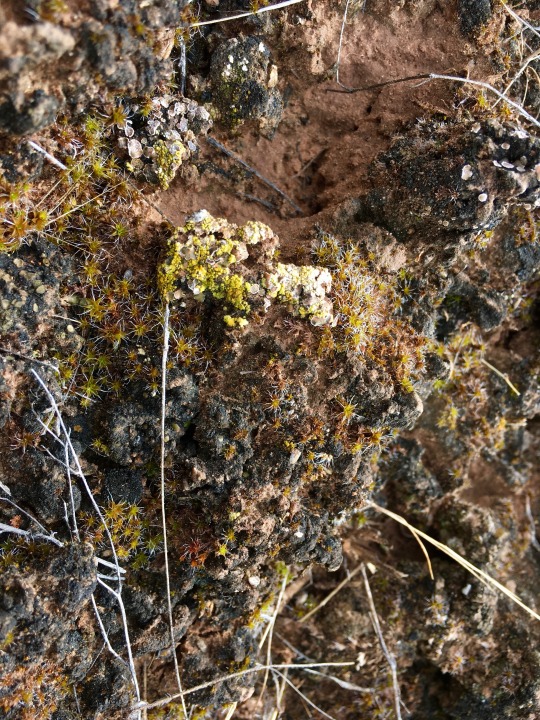

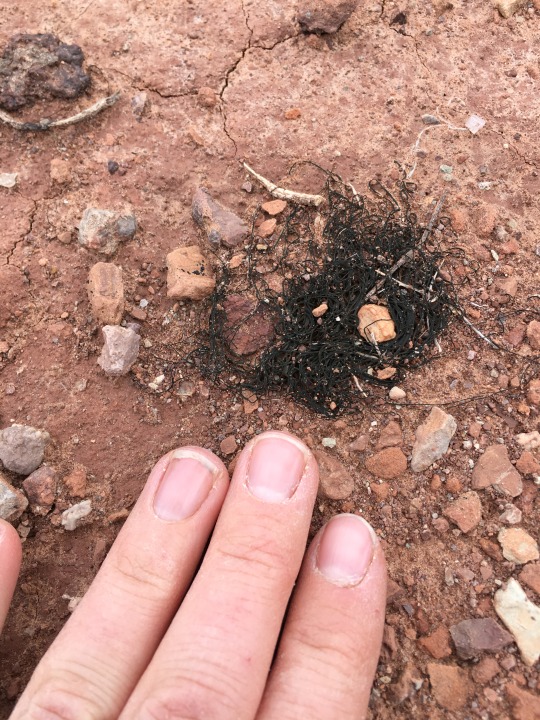
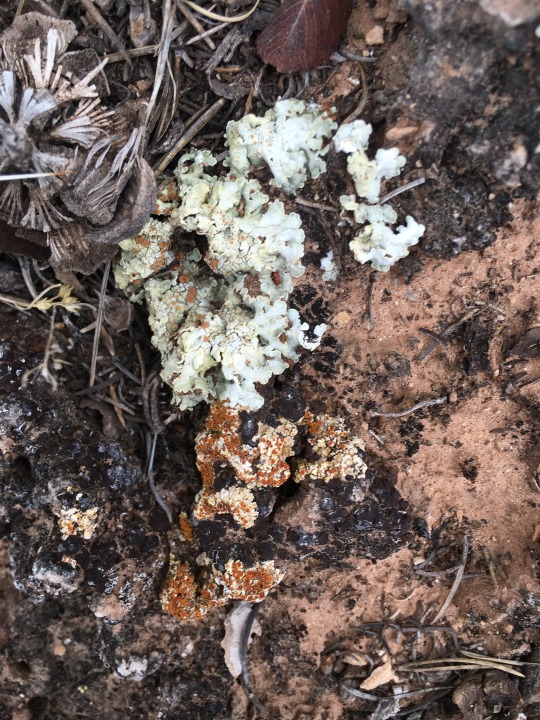

anyway this post is long enough already so i'll be quick. while beautiful and important as you can imagine these are FRAGILE. if they get trampled too much, by humans or cows or cars, that's it. you're back to bare soil that can blow away whenever it wants.
I was lucky to get to participate in a 2x/year survey of one of the very few places in Utah to NEVER have cattle grazing or development, a remote area the entrance is kept secret to inside Canyonlands National Park, where you can see just how dense and lush biocrusts once could be in the US southwest:

ah... glorious. what special little guys. this is why if you visit many of the national parks in Utah you will see signs & stickers around with slogans like "Don't Bust The Crust" and "Tiptoe Through The Crypto" and etc. so heed that advice but DO stop and kneel down and get a better look at them!
#LONG POST#if you dont like long posts you can turn on the collapse posts feature in settings fun fact dont yell at me for your own dash choices#deserts#desert southwest#biocrusts#biological soil crusts#now if i could get myself onto a videogame design team you'd bet id put THESE in those desert regions#its fantasy land give me beautiful fantasy biocrusts... so sad to see them all extinct in thedas how many druffalo did they graze... anyway#replies#ramblings#dreadfutures#i spent a beautiful weekend in monteray once. for a conference but i skipped a day to go to the aquarium and sea kayaking which was great#didnt get to go to the dunes but DID get to jump in the very cold ocean a bunch which is always a treat for a desert rat#all photos mine btw thats why theres no credits
60 notes
·
View notes
Text
Ok can I just say that I love love LOVE the environmental horror of the Southern Reach trilogy. It doesn't overdo it, it doesn't choke out the nature and replace everything by indescribable things. The monsters are evenly spaced out, in a sense- if there was an endless barrage of cosmic horror, you'd grow numb. But not in Area X. Area X is a beautiful bayou, a lovely piece of southern US nature, a love letter to its swamps and coastlines. It just so happens that it wants you to change. It wants you to adapt. It will mess with your head, it will tear the sky apart to hurt you, it will chew up and spit out whatever you give it, it will make you something else. Area X isn't some sort of video game world plagued by monsters. It's a real life ecosystem. It just so happens to harbor a mysterious tower, a mysterious sermon, strange human-sized blobs of lichen growing where people used to be.
194 notes
·
View notes
Text
Delicious in Dungeon in The Kitchen
So... I was struck by the thought that I kinda wish some food nerd would go through the Dungeon Meshi dishes and analyze them and sort of give a "this is the real world thing they're making" run down.
And then I realized I'm a food nerd that can do research.
So.
We're gonna try this out, starting with Volume 1. I don't promise that I know everything about cooking. I don't promise I'll always be able to make the thing I'm looking at (I am broke, and I don't have my own kitchen). But I can at least look at a dish and figure out what they're doing and how to replicate it, at least sorta.
Dungeon Meshi Volume 1-- Huge Scorpion and Walking Mushroom Hot Pot
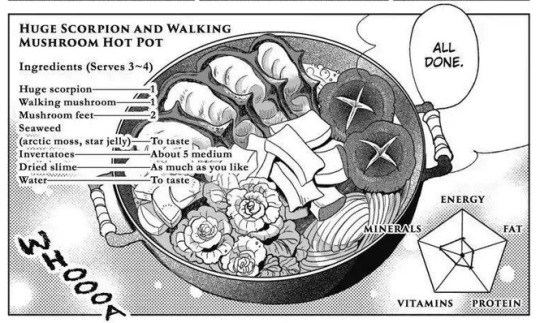
The two main components of this dish are the Huge Scorpion and Walking Mushroom.
Walking Mushroom
Looking at the images in the manga, Walking Mushroom seems to just... be a mushroom that can walk around. There are no organs, the interior seems pretty uniform in substance...

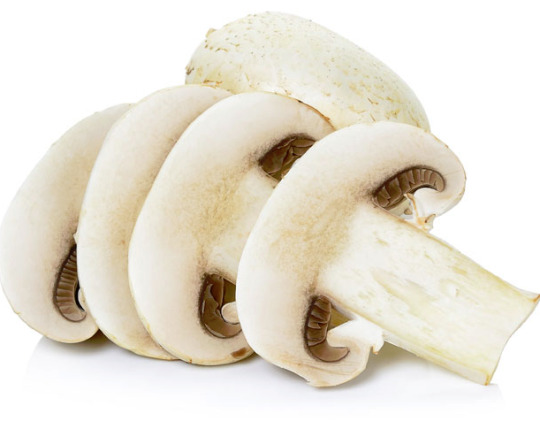
Like, literally, that's exactly what sliced mushrooms look like. Senshi cuts the mushroom into ~4" strips (judging by their size next to the small cabbage-like vegetable, and comparing those plants to his hand in the image of him gathering them. I am assuming dwarf hands are roughly the same size as human hands).
There's a variety of edible mushroom that is probably as close as we're going to get to the size of a Walking Mushroom, growing a cap up to 3' wide, but it seems to only grow in termite mounds in a very specific part of the African continent (please forgive my USAmerican, White education leading me to not being able to identify the specific region), so... if you can get that at all, it's probably crazy expensive (as it should be, unless you're literally getting it from the mounds or local markets yourself). Portobello or similar large culinary mushrooms are probably just fine. The Mushroom Feet are literally just mushrooms, so no worries there.
Huge Scorpion
Ok, so... there is a difference between arachnids and crustaceans. As a start, arachnids have book lungs and crustaceans have gills. Arachnid guts are different from crustacean guts, just because of environment. Hell, crustacean limbs grow differently from arachnid limbs.
That said, everything I see in Dungeon Meshi implies that, from a culinary standpoint, Huge Scorpion is a crustacean-
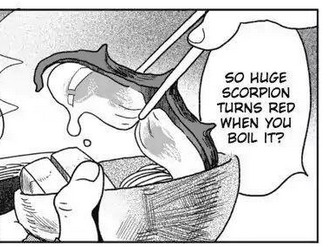
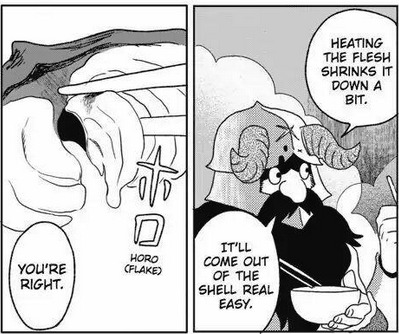
So, really, it's just a big lobster. Take a lobster, cut off its legs, antennae, and the tail fluke, and you're going to see something that looks pretty similar to the huge scorpion in Dungeon Meshi.
Seaweed
Next is seaweed, which... is just a thing, but also kind of an imprecise term, I think. Basically, "seaweed" just refers to any marine algae that is multicellular and macroscopic (big enough to see). Arctic Moss seems to be a real thing which refers to a couple things- the aquatic moss Calliergon giganteum and the terrestrial lichen in the genus of Cladonia, which includes Reindeer Lichen.
Reindeer lichen is edible, in a number of ways, but it's also not seaweed. So we look at Calliergon giganteum. I cannot get an answer as to whether this particular variety of moss is edible. So... fuck it, say Senshi used Reindeer Lichen, at least we know that's edible.
"Star Jelly" is... I don't know. The main result I find when googling it is that it's the sort of general term for various slimes that show up on lawns and other vegetation, etc. Which means it could be anything from amphibian spawning jelly to who the fuck knows what.
However, one thing it could be is a cyanobacteria known as Fat Choy, a commonly used "vegetable" in Chinese Cuisine:
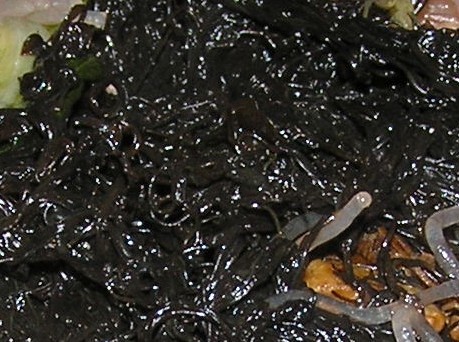
Looks like jelly? Yep. Looks weird enough that you might imagine it comes from a star? Yep. Edible? Yes!
(I mean, maybe don't eat a ton of it, or get it from irreputable sources. At least some Fat Choy contains a toxic amino acid which may or may not have negative health effects, but I'm not a doctor, so all I'm saying is "be aware of this." It's an expensive delicacy, which means that it is a particularly lucrative target for counterfeiters, and China does not have strong, or strongly enforced, food safety laws).
The Hard Stuff
So that leaves "Invertatoes" and "Dried Slime."
Neither of which seem to have a good direct analogue to the real world. Well... sorta.
Invertatoes seems to refer to the plants. The name calls to mind potatoes, and potatoes do indeed grow in the ground and are starchy. It's probably fair to just use any kind of starchy tuber as the "invertatoes." Maybe cassava, since those are large enough that it's at least somewhat believable that "Fantasy Land Cassava" could look like that (although that doesn't fit the "these are normal plants that grow upside down" unless we're being really generous).
The problem is that it's sort of implied that the cabbage-like vegetable seen in the hot pot comes from the same plant, and everything from a potato plant other than the potato itself is toxic. They also don't look like that.
I literally don't know what those cabbage/lettuce-like leafy vegetables are. They're not seaweed, because the two varieties called out definitely don't look like that. They're not, so far as I can tell, the greens of any kind of starchy tuber--
EXCEPT.
So, I was taking one last look at tubers to see if I could find something that seemed to match, and I think Invertatoes could be likened to something similar to chicory. Particularly endives. I never knew endives were related to chicory (ie, "that thing that I'm aware is popular as a coffee substitute in the South, but I don't have much desire to try it, and I wonder if it even has caffeine..."), but, apparently, yeah. Endives are a member of the chicory genus.
So, yeah, lets say that Invertatoes are a sort of fantasy plant similar to the various members of the chicory genus. The trunk can be replicated with chicory root, and the leaves with endives.
That leaves Dried Slime. Dried Slime makes up the noodles in the hot pot, which implies that the noodles are gelatinous, and probably low in gluten. Senshi's explanation of the slime makes me want to think of it as a macro-unicellular lifeform, but... I'm not sure that's accurate.
While it's definitely not an accurate way to describe a jellyfish, I could definitely see a non-biologist describing jellyfish in a way similar to the way Senshi describes the slime. I could also see some fantasy terrestrial jellyfish thing hunting in a similar manner to the slime. Moreover, there are edible varieties of jellyfish, and they're processed in a manner very similar to what Senshi describes for processing slimes. And one way of preparing edible jellyfish is to thinly slice it into noodles.
Hot Pots
I... think this is using a very specifically Japanese sense of "hot pot" (which makes sense), because in Japan, hot pot can refer to a dish called nabemono, while in general, hot pot refers to a particular kind of dining in China where you get a pot full of boiling stock/broth and a bunch of raw ingredients, and you put the stuff you want into the broth at the table. Nabemono is more of "put a bunch of stuff in a pot, and cook it. Serve it boiling." Which is to say, it's soup.
Senshi puts the scorpion meat and mushroom into a pot on its own, and lets it start boiling-
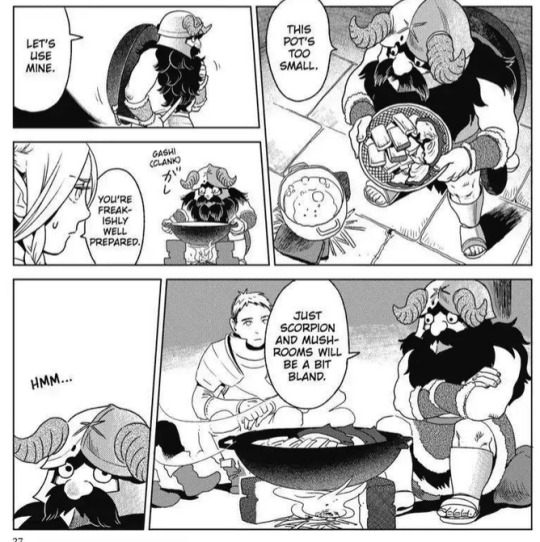
Then, while it's boiling, he goes and finds other ingredients, coming back with the invertatoes and the slime. The two are prepared simply-
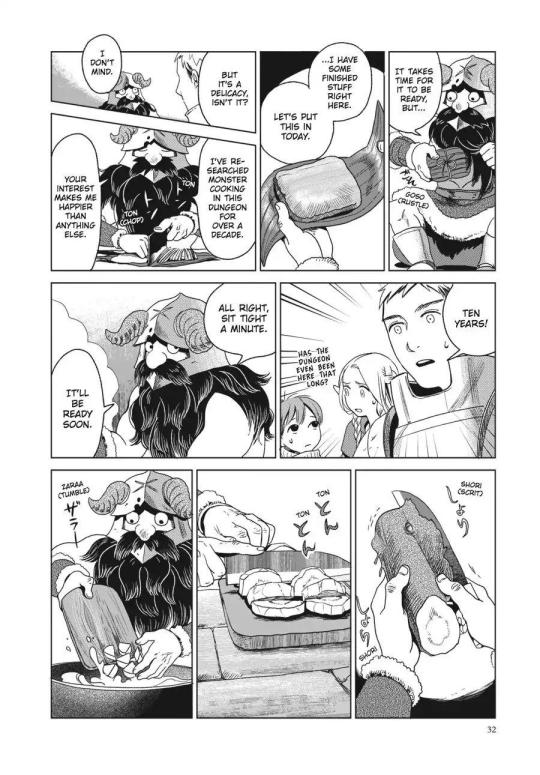
Seasoning isn't included in the ingredients, but I can understand this as a choice for presentation. We do see Senshi add something to the broth after tasting it, and I think it's fair to assume it's one of soy sauce, mirin, fish sauce, or similar. I think it's actually really interesting that we see Senshi add seasoning, but we're not told what it is-
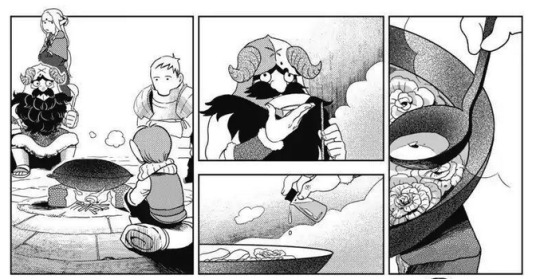
Because... that's cooking. You can follow a recipe, but ultimately, you need to taste your cooking and make your own decisions. Senshi lets the soup cook, tastes the broth, decides it needs something, and gives it a bit of time to let the flavors meld before serving it up.
Dungeon Meshi Lobster and Mushroom Hot Pot
So, we're looking at something like this for the "Huge Scorpion and Walking Mushroom Hot Pot"--
Lobster- ~5 lbs or more (a 1 lb lobster yields about 4 oz of actual meat, which is a single serving), cut into large slices
Portobello- 2 mushrooms large diced, 2 left whole with the caps scored
Reindeer Lichen and Fat Choy- to taste
Chicory Roots- ~1 cup, diced
Endive greens- ~2 cups
Jellyfish, thin sliced- as much as you like
Add lobster and mushrooms to water, and allow to boil. While it comes to a boil, prepare the other ingredients, then add to the water. Let the soup come to a full boil, then reduce heat and simmer for 15 minutes to an hour (can simmer longer, but this will affect the texture of the ingredients. Longer simmering will result in more melding of flavors, but also degraded solid parts).
Taste the broth. It will likely need salt and acid, which could come in a variety of forms, such as kosher salt and lemon juice, soy sauce and mirin/rice vinegar, oyster/fish sauce, or something else. Go with your gut and your taste buds..
#Dungeon Meshi#Defictionalization#Cooking#Food#Huge Scorpion and Walking Mushroom Hot Pot#Lobster and Portobello Hot Pot#This actually isn't really my thing due to the mushrooms but hell#Cashapp: $ValravenApocalypse#Paypal.me/Korbl#Ko-fi.com/valravenapocalypse#If this gets 100 notes and people like it I'll do the carnivorous plant fruit tart#Delicious in Dungeon
105 notes
·
View notes
Text
The Real Life Biology of the Three Body Problem Series
In the first book of Liu Ci Xin's Three Body Problem series, we are introduced to our main antagonists, the Trisolarans. Whilst we never get to see them directly, we are shown some of their biology via the game that our protagonist plays.

ID: A grand domed palace in a chinese style sits in the background of the image. The foreground has hundreds of ancient Chinese soldiers holding white placards on sticks. Two people dressed in Chinese armour can be seen riding horses towards the palace.
In the game it is revealed that Trisolaris, the planet in the Alpha Centauri system on which the aliens reside, revolves around not one, but three suns. As such, the system is subject to the classic physics conundrum of the three body problem (after which the first book in the series is named), which states that for most initial conditions the trajectories of three celestial bodies is chaotic and difficult to predict.
This means that Trisolaris experiences very extreme, unpredictable conditions, divided into "stable eras" and "chaotic eras". Stable eras come about when Trisolaris settles into orbit around one of its three suns, bringing relative prosperity to the planet. However, chaotic eras result in disasters, such as extreme droughts, seemingly endless nights, and even changes in gravity. The first novel partially revolves around the Trisolarans attempting to see if humans could collectively solve the three body problem and bring some level of predictability to their planet.
During the course of the game, it is revealed to the protagonist (and us, the readers), that in order to cope with the devastation and unpredictability of chaotic eras, the Trisolarans can dehydrate themselves and enter a spore-like state, hibernating until the next stable era comes. This allows them to bypass some of the extreme conditions and ensures the survival of the species as a whole.
Believe it or not, we have our very own Trisolarans here on Earth. In fact, there's loads of examples, from bacteria to triops, to my favourite of the bunch, Bdelloid Rotifers.
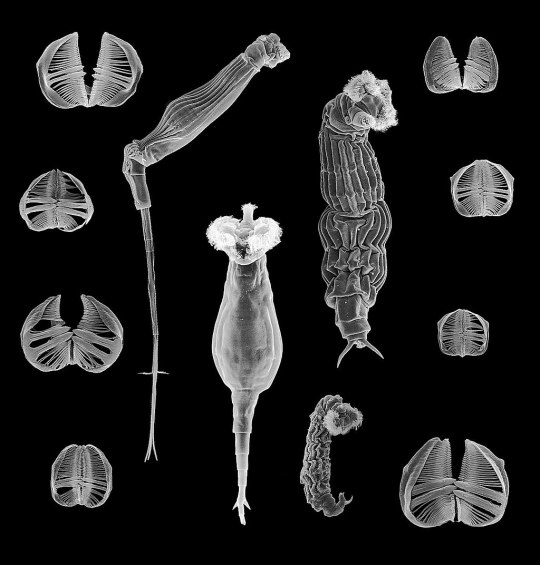
ID: An electron micrograph of some Bdelloid Rotifers and their mouthparts. They are long and slender, with a distinct mouth and tail section. Their mouthparts look like two semicircles lined with a comb-like structure.
These microscopic animals look freaky, because they are. If you've got any media literacy you've probably picked up by now that I am segueing here because they are somewhat similar to the aliens in the Three Body Problem, except this time they are very much real. Like the Trisolarans, Bdelloids live in very ephemeral environments: their usual haunts are the very thin film of water on moss and lichen. As you can imagine, these do not last all that long, and thus when they dry up, so do the Bdelloid Rotifers; in biology, we call this process anhydrobiosis.
"Ok, that's all well and good Ocean Sunfish Hater, but why do you like these guys more than the other anhydrobiotic creatures that roam our good, green Earth?" I hear you ask.
So you know how things that reproduce asexually don't have all that much genetic variation, and how sexual reproduction gives you an edge over asexual populations since you can keep that genetic variation fun and funky fresh, and how that has been the cornerstone for eukaryotic reproduction? Well. Well. Just like me, Bdelloid Rotifers have been completely celibate for 35-40 million years, with some people even bringing that number up to 100 million years, when they diverged from their sister clade. So how do these turbo-virgins not go extinct, racking up tonnes of deleterious mutations, not having any advantageous innovations, and eventually exploding into a genetic soup?
The secret lies in their ability to dehydrate. Not only is it a really handy dandy way to stay alive when your only source of water is gone, it literally rips apart their cells and genes! And why! Why the fuck does that help? It sounds like the opposite of helping!
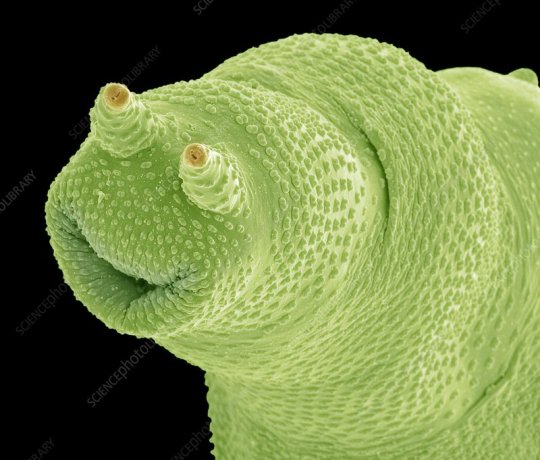
ID: An electron micrograph of the foot of a Bdelloid Rotifer. It has been shaded a light green. The structure looks almost like a face, with a smile and two stalk-like structures that could be mistaken for eyes. But this is not a face.
Having this mild-to-moderate level of cell membrane and chromosomal damage enables the Bdelloids to take up genetic material from their environment, mostly via their digestive systems, where their last meals are slowly being broken down to reveal that juicy DNA inside. When the water returns and the Bdelloids rehydrate, this genetic material gets incorporated into their chromosomes as their cells get back to work repairing themselves. And they sure ain't picky. In fact, it has been shown that in some species of Bdelloids, up to 8% of their genetic material has non-animal origins. How cool is that?
This is probably what has allowed them to continue adapting and evolving, even when they have been reproducing asexually for so long. This strategy has been so successful that the Bdelloids have managed to diversify into over 450 species. Pretty impressive for a class of animals that haven't had sex in over 40 million years.
Perhaps the Trisolarans might have a similar mechanism as part of their biology (even if they do reproduce sexually as stated in the book). Maybe they've managed to survive for this long because they have been able to absorb useful genes from their home planet, just like Bdelloids have been doing here on Earth. I don't know if these are what Liu Ci Xin had in mind when he wrote the Three Body Problem, but they sure were what I was thinking of when I read the book.
If you're still here, thanks for reading! I know this was a bit of a longer post, but I just wanted to use the new Netflix show to talk about one of my favourite books and one of the weirdest, most underappreciated animals.
#I would like trisolaris because the ocean sunfish would not survive there#bdelloid rotifers are so fucking cool and i think more people need to know about them#biology#ecology#Trisolaris#three body problem
101 notes
·
View notes
Note
Ok now I'm really curious. What WOULD be a "wow, your parents must have really hated you" name in oichen culture
this question made me LAUGH. i asked rafi to help me think about it because oichen naming conventions don't lend themselves to the biggest "your parents must have hated you" trends in american english names, ie: being "renesmee" or being "trinity hope patience chastity grace taylor."
so there are two answers depending on the scenario.
one option is that your parents DON'T hate you, and they HAVE complied with cultural naming conventions re: naming you after their interests/values/memories/love, BUT the name is unusual in a way that makes people go 🤨🤨🤨.
easiest way to achieve this is if you have some weird, esoteric interests that you decide to name your child after. things that other people may not see the beauty in. like, naming a child after your love of insects is very sweet, and the kid might grow up to love bugs as much as you do, but other people may also be like HEY. WHY IS YOUR KID'S NAME "STINGING WASP." WHAT DID THEY DO????
or irl i said, "maybe you love this one isolated swamp cave outside your town and you spend all your time studying lichen in the swamp cave and your child is eventually conceived in the swamp cave, so you name them 'swamp cave' with no regard for how that sounds," and rafi immediately said, "GANSEY."
then the second potential situation is one where you actually DO hate your child.
i think the Easiest way to name a child you hate is by naming them after a relative, honestly. because then it's like, aww, you share your granny's name, isn't that sweet :) i'm preserving grandma's memory through you :) this is a nice thing to do :) when in actuality you just don't want to give this hellspawn anything of your personality or values.
the other suggestion rafi made, which is more subtle and hilarious, is to name your child after, like, dreams you had to give up when you had a kid. hi, i'm Successful Fifty-Year Career In The Arts! and these are my siblings, Beautiful Home Alone On The Seashore and Never Having A Bitch-Ass Husband Who Won't Do The Dishes .
#replies#those last ones are obviously jokes and not true oichen names. but imagine the comedy timeline where they are.#original fiction#worldbuilding
29 notes
·
View notes
Note
hi!! I was doing some research for a lil project a while back, and I stumbled across the funniest article of all time imo. You probably know about it given lichens and all that, but if you haven't I think it would be a shame to be missing out on it.
I'm not sure if Tumblr blocks links on anon so it's A Short History of Lichenology by Charles C. Plitt! Favorite quotes include:
Even Linnaeus dubbed them the "rustici pauperrimi" of vegetation, which has been quite properly translated, the "poor trash" of vegetation.
It goes without saying, that most of these ideas were not founded upon direct observations, but were merely opinions.
It invests them as a spider her prey, with a fine meshed web, which gradually is converted into an impregnable integument, but, whilst the spider sucks out her prey and throws it aside when dead, the Fungus stimulates the Algae, found in its net, to more lively activity, in fact, causes them to grow larger and causes thereby a luxuriant growth and the thrifty appearance of the whole colony.
- @hotmushroompics
Oh my gosh I love old descriptions of lichens. First off, Linnaeus, RUDE. I can't believe that guy. Second, so much lichenology still rests in the realm of opinion since lichen observation is difficult. Why do they do everything so slowly??? Third, not a good enough reason to use the word "stimulate," but ok, whatever. I will have to make a post on historical lichenology one of these days. It's so fascinating and dramatic, and includes a long-standing feud between Beatrix Potter (yes THAT Beatrix Potter) and the Linnean Society (sexist asshats).
30 notes
·
View notes
Text

I forgot to post this because I finished it at like 12 and then I was too busy looking at what cool lichens I could add to her and then I ended up far down a Wikipedia rabbit hole at 2 am.
Anyways lichens are literally so cool because they are like THE symbiotic relationship. Like the 2 components most lichens have (Algae and fungi) are so intertwined that they are considered their OWN SPECIES?!?! THEIR OWN FAMILY?!?! Like when most people refer to symbiosis they refer to things like clown fish and anemones, which is a good example but both can survive somewhat without each other. But the algae and fungi that make up lichens are SO intertwined that they can be considered species of their own and are often ONLY seen with each other! That’s like if clown fish and anemones became so reliant on each other that they merged and became their own species. THAT IS SO AWESOME PEOPLE NEED TO TALK ABOUT THIS MORE PLEASE IVE BEEN HOLDING THIS INFORMATION IN FOR SO LONG AND NOBOY CARES WHEN I EXPLAIN HOW COOL THIS IS.
Ok deep breath guys sorry you had to deal with that infodump but if anyone ever asks me about plants/fungi/algae I will never shut up they are my special interests and I will never get tired of them.
Anyways I added some Foliose lichen to sequoia’s back instead adding those web thingys. I also tried to add some flavoparmelia caperata on the knot near the end of her wing since it’s one of my favorite kinds of lichen. I also added some of this one type of mushroom that usually appears on older trees but I forget its name.

Hehe haha anyways I’m totally normal about plants you guys should ask me about plants because I am sooo normal about them it’s crazy.
#wof#wings of fire#wof art#watercolor#leafwing#queen sequoia#sequoia wof#sequoia#lichen#moss#mushrooms#foliose lichen#hehe sorry#info dump#special interest#plants
33 notes
·
View notes
Text
My yard has lots of inclined areas because we live on a ridge. It's heavily forested so lots of SHADE so my gardening areas are limited but thats ok. Lots of forest plants to love. The ph is very acidic for soil too. So there is a LOT of MOSS. I love my moss. Just rained last night so here have some freshly filled with rain spongy moss pics. And lichen. I like lichen too. It's not fluffy like the moss tho.







12 notes
·
View notes
Text


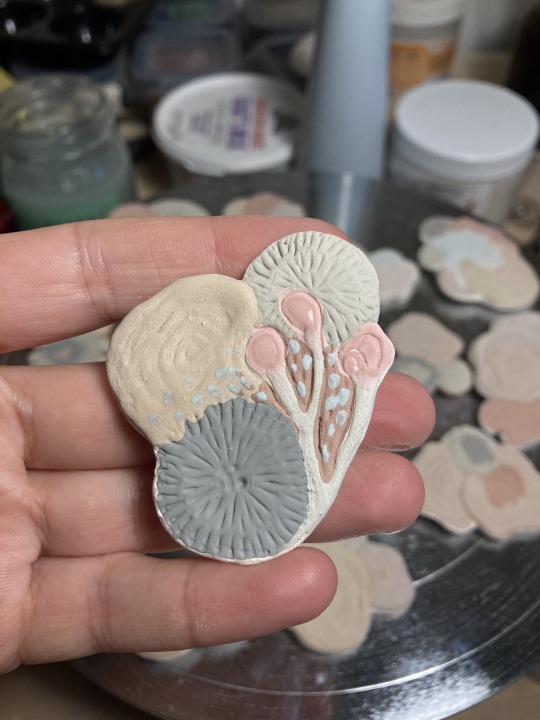

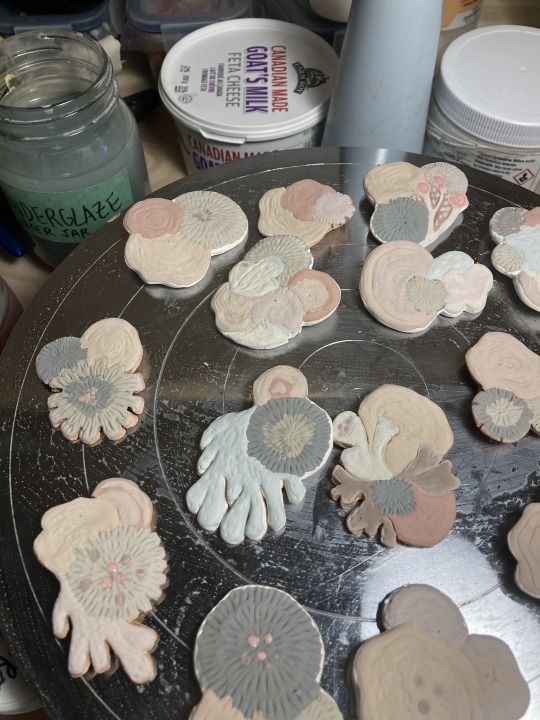
I'm powering through this glazing round now that the more intricate mug designs are done - these lichen pendants were quicker than expected to glaze & I'm SO curious to see how they turn out once fired...I did some real experimenting with layering/butting-up glazes beside each other & I'm hoping it's neat!
Glazes used include a bunch from my two Coyote sample sets (Enduro colour glazes & cone 6 Shinos) plus a few from the Mayco 2023 new glaze sample set (ivy, riptide, coral gloss & fossil rock). I took pretty-ok notes, so I'll post these again once they're fired with some annotation, as they'll probably be the most interesting glaze pieces from this whole batch!
#artblog#ceramicsculpture#ceramicart#handbuiltceramics#sculptures#handbuiltsculpture#pottery#clay#stoneware#sculpting#sculpture#handbuilding#ceramic#ceramics#glazing#mayco#coyote glaze#ceramic pendant#pendant#handmade pendant
167 notes
·
View notes
Note
Ok so I’m a little bit obsessed with your blog already (as of discovering it 5 whole seconds ago) 😅
I do 3D scanning as part of my job, but with a structured light scanner. I’ve thought about scanning a foliose or fruticose but haven’t attempted yet - or seen anyone else try scanning lichen - until now. To get those results with photogrammetry really is good going!
Also the capsule lids on your sphagnum moss are insane! If you have any macro setup recs or tips you don’t mind sharing, I would love to hear them. I have a decent macro lens, but still trying to find the right lighting option for super close-up work.
Thankyou for the kind words. <3
Photogrammetry: I feel like lichens are not an easy fit for current photogrammetry tech, but flat photographs frustratingly limited for lichen identification - it would be *so good* to have examples that you can view in the round. So it's worth trying to make it work.
I really want to make 3d models of tiny things: liverworts and smaller lichens stand to gain the most in terms of accessibility from being shown in 3d.
Macro: taking things home instead of shooting in the field is new to me, but nearly all of my photos are still done with available light - either on a windowsill or in a side-room with a glass roof. My macro lens is 100mm which is long enough that the camera overshadowing the subject is not usually an issue.
This is the first year I've done much > 1:1 macro work. I'm not sure what happens in the winter - it will be too dark to do anything at all on some days, so maybe I will be looking at alternative lighting setups soon...
17 notes
·
View notes
Text
Once you've learned to correctly pronounce every word in this poem, you will be speaking English better than 90% of the native English speakers in the world
Dearest creature in creation, Study English pronunciation. I will teach you in my verse Sounds like corpse, corps, horse, and worse. I will keep you, Suzy, busy, Make your head with heat grow dizzy. Tear in eye, your dress will tear. So shall I! Oh hear my prayer.
Just compare heart, beard, and heard, Dies and diet, lord and word, Sword and sward, retain and Britain. (Mind the latter, how it's written.) Now I surely will not plague you With such words as plaque and ague. But be careful how you speak: Say break and steak, but bleak and streak; Cloven, oven, how and low, Script, receipt, show, poem, and toe.
Hear me say, devoid of trickery, Daughter, laughter, and Terpsichore, Typhoid, measles, topsails, aisles, Exiles, similes, and reviles; Scholar, vicar, and cigar, Solar, mica, war and far; One, anemone, Balmoral, Kitchen, lichen, laundry, laurel; Gertrude, German, wind and mind, Scene, Melpomene, mankind.
Billet does not rhyme with ballet, Bouquet, wallet, mallet, chalet. Blood and flood are not like food, Nor is mould like should and would. Viscous, viscount, load and broad, Toward, to forward, to reward. And your pronunciation's OK When you correctly say croquet, Rounded, wounded, grieve and sieve, Friend and fiend, alive and live.
Ivy, privy, famous; clamour And enamour rhyme with hammer. River, rival, tomb, bomb, comb, Doll and roll and some and home. Stranger does not rhyme with anger, Neither does devour with clangour. Souls but foul, haunt but aunt, Font, front, wont, want, grand, and grant, Shoes, goes, does. Now first say finger, And then singer, ginger, linger, Real, zeal, mauve, gauze, gouge and gauge, Marriage, foliage, mirage, and age.
Query does not rhyme with very, Nor does fury sound like bury. Dost, lost, post and doth, cloth, loth. Job, nob, bosom, transom, oath. Though the differences seem little, We say actual but victual. Refer does not rhyme with deafer. Foeffer does, and zephyr, heifer. Mint, pint, senate and sedate; Dull, bull, and George ate late. Scenic, Arabic, Pacific, Science, conscience, scientific.
Liberty, library, heave and heaven, Rachel, ache, moustache, eleven. We say hallowed, but allowed, People, leopard, towed, but vowed. Mark the differences, moreover, Between mover, cover, clover; Leeches, breeches, wise, precise, Chalice, but police and lice; Camel, constable, unstable, Principle, disciple, label.
Petal, panel, and canal, Wait, surprise, plait, promise, pal. Worm and storm, chaise, chaos, chair, Senator, spectator, mayor. Tour, but our and succour, four. Gas, alas, and Arkansas. Sea, idea, Korea, area, Psalm, Maria, but malaria. Youth, south, southern, cleanse and clean. Doctrine, turpentine, marine.
Compare alien with Italian, Dandelion and battalion. Sally with ally, yea, ye, Eye, I, ay, aye, whey, and key. Say aver, but ever, fever, Neither, leisure, skein, deceiver. Heron, granary, canary. Crevice and device and aerie.
Face, but preface, not efface. Phlegm, phlegmatic, ass, glass, bass. Large, but target, gin, give, verging, Ought, out, joust and scour, scourging. Ear, but earn and wear and tear Do not rhyme with here but ere. Seven is right, but so is even, Hyphen, roughen, nephew Stephen, Monkey, donkey, Turk and jerk, Ask, grasp, wasp, and cork and work.
Pronunciation -- think of Psyche! Is a paling stout and spikey? Won't it make you lose your wits, Writing groats and saying grits? It's a dark abyss or tunnel: Strewn with stones, stowed, solace, gunwale, Islington and Isle of Wight, Housewife, verdict and indict.
Finally, which rhymes with enough -- Though, through, plough, or dough, or cough? Hiccough has the sound of cup. My advice is to give up!!!
30 notes
·
View notes